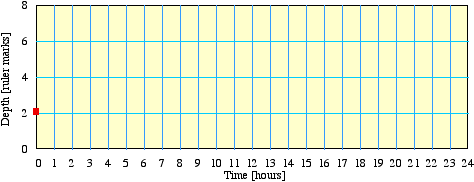
Watch the movie and read the text on the accompanying website. When you are comfortable with the concepts, answer the following questions.
1) As the Earth rotates over the course of 24 hours, how many high tides does our yardstick encounter? How many low tides?
2) How many hours separate a high tide from the next low tide? Separate high tide from the next high tide?
3) Where was the yardstick relative to the direction of the moon when the tide was high? Low?
4) In our model, lets find out exactly how the water depth changes over the course of 24 hours. Imagine you are standing on the Earth next to the ruler, and that you measure the depth of the water each hour.

Your graph predicts how the water depth should vary over 24 hours according to our very simplified model. Let's test the prediction by comparing it with real data. The National Oceanic and Atmospheric Administration (NOAA) measures the water depth at various stations around the country and the results are posted on its web page. Click here to get a record of the recent tides at Nantucket, MA (an island off the South shore of Cape Cod), or see the link on the main Tides Activity webpage.
You should see a graph showing water depth ("Feet Above MLLW", where MLLW is the average water depth where the measurement is taken - maybe at a dock) as a function of time. The red line is actually a series of crosses marking the observed water depth at different times. (Below this graph is another graph showing air and water temperatures -- you can ignore it).
5) How well does your prediction match the observed behavior of the tides? What aspects of real tides does your prediction get "right" and what does it get "wrong"?
6) Can you identify any failings or over-simplifications in our model (the movie)? Do they account for the mismatches between prediction and observation in #5? If so, how?